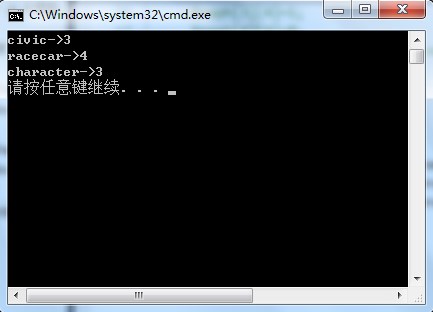#ifndef PALINDROME_H_#define PALINDROME_H_#include<iostream>#include<string>int palindrome_longest(char *str,int front,int back);#endif
#include"Palindrome.h"#define Max(a,b) a>b? a:bint palindrome_longest(char *str,int front,int back){int pali_count=0;if(front==back)return pali_count+1;if(str[front]==str[back]){pali_count=palindrome_longest(str,front+1,back-1)+1;}else{pali_count=Max(palindrome_longest(str,front+1,back),palindrome_longest(str,front,back-1));}return pali_count;}
#include "LongPath.h"#include "Palindrome.h"int main(){char *str="civic";char *str0="racecar";char *str1="character";std::cout<<palindrome_longest(str,0,4)<<std::endl;std::cout<<palindrome_longest(str0,0,6)<<std::endl;std::cout<<palindrome_longest(str1,0,8)<<std::endl

在上面的算法中,我们采用了求最长公共子序列一样的算法,也就是《算法导论》第三版 15-4节。
其思想很值得借鉴。对于处理这些“非正规”的子符串问题很有启发性,对于最长公共子序列,并
不是我们以前志熟悉的那种连续性的最长公共子序列,而是求不要求连续性的公共子序列,于是知
我们不能从两个子序列都开始缩进或者退避。


这就是这些问题的特点。
对于这个问题的回文是,我们采用类似的思想,如果相等,那好,他们回文的长度加1,如果不相等,那
只有其中的一端要牺牲一下啦,它要退回一个字符,然后求这两个的最长的那个就行了。
if(str[front]==str[back]){pali_count=palindrome_longest(str,front+1,back-1)+1;}else{pali_count=Max(palindrome_longest(str,front+1,back),palindrome_longest(str,front,back-1));}
以上就是核心的代码。永远只牺牲一端。不会同时退避两端。
